|
|
|
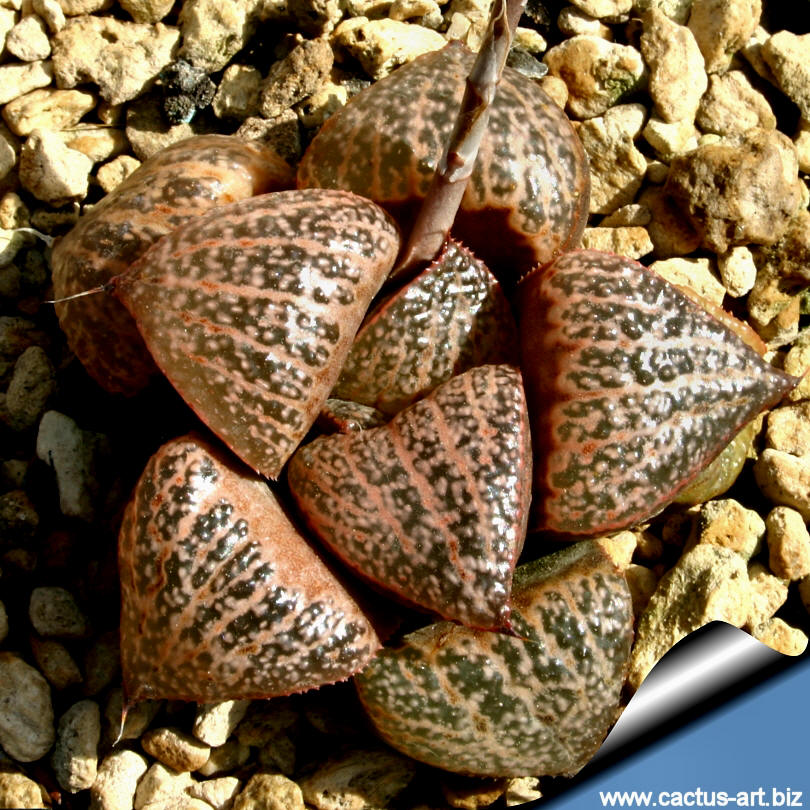
Haworthia magnifica var. splendens (Standard form - West of Albertina )
Really magnificent and
splendid as the species name implies
|
|
Description: Haworthia magnifica var. splendens
is a slow growing
species that stay usually solitary but that can occasionally
proliferates after several years. The superlative epithets of this
variety give a hint of the exquisite beauty of this plant, that shows
shades of bronze-rose in half shade culture. It is similar to
H. truncata but the growth
and arrangement of the fat windowed leaves is mounding.
Stem: Stemless.
Rosettes: Up to 8 cm in diameter that flush at soil level in
habitat.
Leaves: Very attractive, spreading and retuse up to 3,5 cm long,
triangular-elliptic, end area triangular, swollen, dark green to
purplish with 4-5 longitudinal silvery-grey lines along the upper
surfaces and with shiny raised tubercles. Margin entire or finely
toothed. The tip of the leaf is more or less translucent between the
veins. If grown properly, the nicest forms resemble little sculptures
and all turn extraordinary colors if treated right: purple, turquoise,
pink, gold, and may be streaked and dotted with white, gold and silver
as well. H. magnifica var. splendens however show wide
variations, this variety alone is enough to keep aficionados of the
genus engaged for generations, selecting from a seemingly vast potential
of degrees of glossiness, colours and translucence, lineate patterns and
papillae. The best colours come just as they enter and exit dormancy.
Flowers: Produces a slender inflorescence up to 40 cm tall, with
15-25 flower, petals white with a brownish-green mid-vein and green
throat. Only few flowers open together at the same time.
|
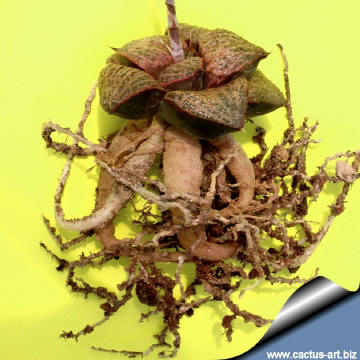 |
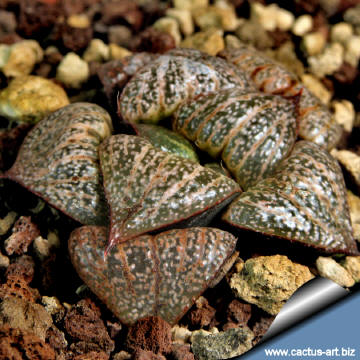 |
|
. |
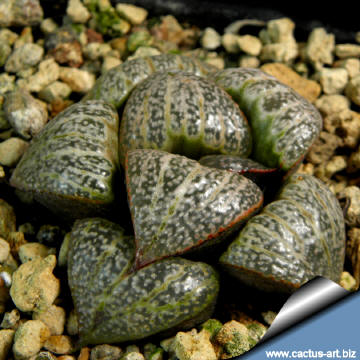 |
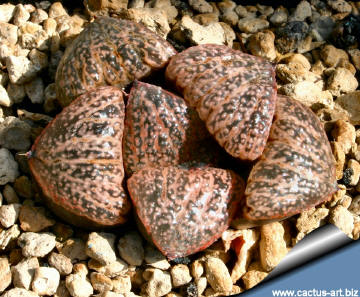
It show wide variations of glossiness, colours and translucence, lineate
patterns and papillae. The best colours come just as it enter and exit
dormancy. |
|
. |
|
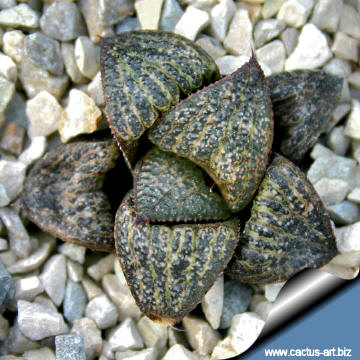
Standard form.
|
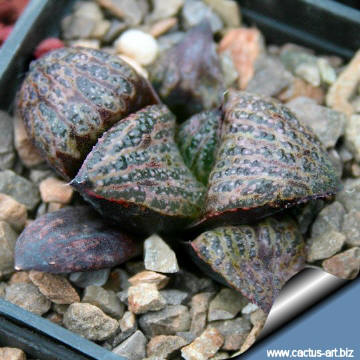
Clone CG337
|
|
Advertising
|
|
|
|
|
Family:
Asphodelaceae
(Aloacee - Liliaceae)
Scientific name:
Haworthia magnifica var. splendens
(G.G. Sm.) J.D. Venter &
S.A. Hammer
In: CSJA 70(4) 180-182. Ills. 1998
Synonyms:
- Haworthia splendens (S.A. Hammer
& D.J. Venter) M. Hayashi 2000
Origin: South africa
Habitat: These plants grow flush with the soil, and their
elaborated coloring actually serves to camouflage them under the canopy
of the sparse bushes and beside protecting rocks.
Their transparent leaf tips and tops act as windows that let light into
their interior so they can photosynthesize from inside, without having
to expose more of the their mass to the potential threats of the great
outdoors.
Etymology:
The
genus "Haworthia" is
named after the British botanist Adrian Hardy
Haworth (1767–1833)
The
specific name "magnifica" derives From
the
Latin word
“Magnificus”
meaning "magnificent,
splendid,
fine”
(The specific name implies:
“magnificent”)
The
varietal name "splendens" derives from the Latin
adjective “Splendens ” meaning “shining, splendid,
magnificent, beautiful”
( The varietal name implies:
"shining,
splendid").
|
|
|
|
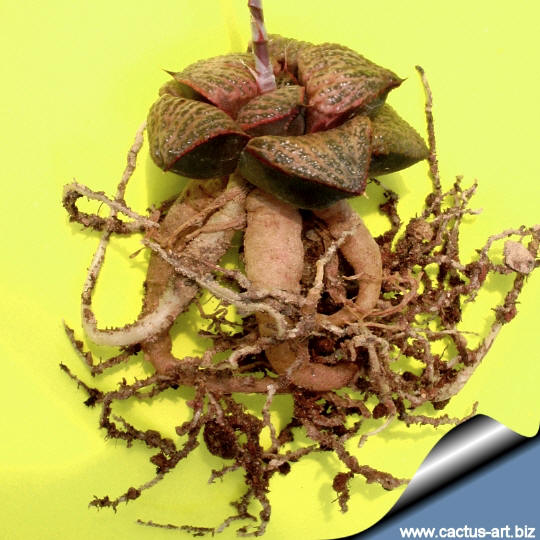
Roots are fleshy and superficial (Needs shallow pots)
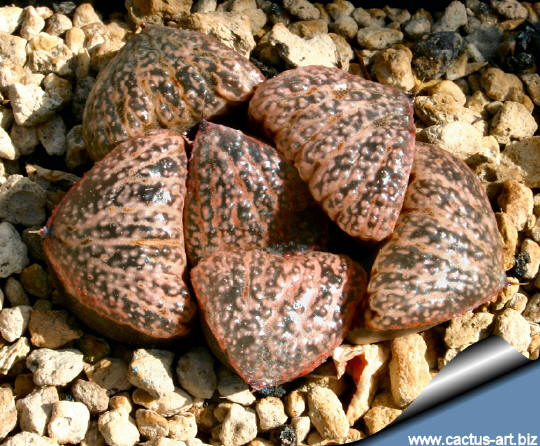
Haworthia magnifica
var. splendens CG337
Cok
Grootscholten (The Nederlands)
This clone has a beautiful tuberculate and splendid epidermis
Cultivation: H. magnifica is a very slow growing species, it needs regular water,
but
do not water again until dry.
Also, it is a species that is dormant in
the winter and require very little water (maybe even none) during the
cold months.
Frost Tolerance: Light frost protection required.
Minimum of
5ºC for safe growing (but hardy up to -5°C or less.)
Sun Exposure: Requires light shade to bright light (protect
from strong
midday sun).
In shade the body colour will remain mostly green, while full sun will
darken and give it a reach pink-red body colour. Can be sunburned if moved
from shade/greenhouse into full sun too quickly. The amount of sunlight
it can withstand without scorching depends upon the how hot it becomes
in the summer in the locale in which it is planted. It will have more
colour if it receives more light. During the spring it may be able to
take full sun until the heat arrives at the end of spring. In an area
that has hot afternoon sun, it may be able to take full morning sun, but
requires afternoon shade or afternoon light shade.
Propagation: In contrast to most of the other
Haworthia, these plants are reluctant or very slow to offset, and some
never do, reproducing themselves only by seed.
Photo of conspecific taxa, varieties, forms and
cultivars of Haworthia magnifica.

 |
|